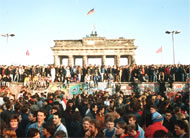| SUMMARY
What’s the Evidence?
 |
|
 |
|
| The fall of the Berlin Wall |
|
|
The power of peace-creating
groups to decrease warfare and terrorism has been tested repeatedly.
The results produced by temporary peace-creating groups (lasting
weeks or months) have been consistently positive—with nearly
immediate reductions in war deaths averaging better than 70%.
In addition, the one peace-creating assembly that lasted for several
years was accompanied by a history-transforming wave of peace
around the world. Most of these studies have been carefully
scrutinized by independent scholars, then accepted
for publication in mainstream academic journals.
Reduced
warfare in Lebanon: During days of high attendance at a group
of peace-creating experts in Jerusalem, war deaths in neighboring
Lebanon decreased by 76%. Increases in attendance at the peace-creating
group also correlated strongly with reduced crime, traffic accidents,
and fires, and with improved economic indicators. DETAILS >
Replication
on warfare in Lebanon: During seven different peace-creating
assemblies—in a two-year study of the nearly continuous fighting
in Lebanon during the mid-1980s—war deaths decreased by
an average of 71%. Some of these assemblies were large (7-8,000
peace-creating experts) and distant (as far away as Fairfield, Iowa,
USA)—indicating that the peace-creating effect can radiate
worldwide. DETAILS >
Reduced
worldwide terrorism: During the three largest peace-creating
assemblies ever held in the West, statistics provided by the Rand
Corporation showed a 72% reduction in worldwide terrorism.
DETAILS >
Wave
of global peace: During the one large peace-creating assembly
(8,000 experts) that continued for several years (1988-90), major
conflicts in the world all came to an end—including the
Soviet invasion of Afghanistan, a seven-year war between Iran and
Iraq that had killed millions, and, most notably and unexpectedly,
the Soviet-American Cold War that had threatened the world with
nuclear annihilation for forty years. DETAILS >
Scientific acceptance:
Time after time, independent scholars have judged this research
to be sound. These scholars have been impressed because the findings
have been often repeated, based on open public data
that other researchers can check, with strong correlations
between peace-creating attendance and reduced social violence, lead-lag
analysis supporting a causal interpretation, and alternate
possible explanations ruled out. DETAILS >
|
To move to the next Summary,
click here:

To continue with more detail on this topic,
click here:

|
| 

